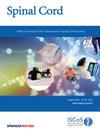脊髓损伤人群中复发性尿路感染的诊断评估和管理——一个三级保健中心的回顾性评估。
IF 2.1
4区 医学
Q3 CLINICAL NEUROLOGY
引用次数: 0
摘要
研究设计:回顾性研究。目的:虽然大多数脊髓损伤(SCI)患者预计每年有1-2例尿路感染(uti),但有一个亚群的发病率较高。我们评估了我们的实践,以确定复发性尿路感染的常见原因,假设更频繁的感染通常具有可解决的危险因素。方法:我们回顾了2015-2020年间在一家三级泌尿外科诊所就诊的脊髓损伤患者,以评估和处理“复发性尿路感染”。随访后,记录尿路感染复发的疑似原因和专科评估后尿路感染的数量(患者报告)。结果:40例脊髓损伤患者在前一年平均接受了4.8次UTI治疗,其中CIC表现最好(80%)。随访后,37/40(92.5%)的患者报告的尿路感染复发的可能原因。在16/40(40%)中,根据指南定义,仔细询问确定患者没有尿路感染。在确诊复发性尿路感染的患者中,与影像学检查(2.6%)或膀胱镜检查(8%)相比,膀胱日记检查(62.5%)或尿动力学检查(64%)更容易确定病因。经过至少1年的随访,90%的人群的尿路感染发生率降低了50%或更多,其中大部分采用了非抗生素策略。结论:在以“复发性尿路感染”为主诉的脊髓损伤人群中,超过三分之一的人没有尿路感染。除了详细的病史外,膀胱日记+/-尿动力学对发现病因和改善尿路感染最有用。本文章由计算机程序翻译,如有差异,请以英文原文为准。

Diagnostic evaluation and management of recurrent urinary tract infections in the spinal cord injury population – a retrospective evaluation at a tertiary care center
Retrospective review. While most individuals with spinal cord injury (SCI) are expected to have 1-2 urinary tract infections (UTIs) per year, there is a subset with higher incidence. We evaluate our practice to characterize common causes of recurrent UTIs, hypothesizing that more frequent infections typically have addressable risk factors. Tertiary urology clinic, San Jose, CA. We reviewed patients with SCI referred to a tertiary urology clinic for evaluation and management of “recurrent UTIs” during the years 2015–2020. Following workup, the suspected cause of recurrent UTIs and number of post-specialty evaluation UTIs (patient reported) were noted. Forty persons with SCI with a mean of 4.8 UTI treatments in the prior year comprised our cohort with most performing CIC (80%). After workup, 37/40 (92.5%) had a likely cause for their reported recurrent UTIs. In 16/40 (40%), careful questioning determined that the patient was not having UTIs based on guideline definitions. In those with confirmed recurrent UTIs, a bladder diary (62.5%) or urodynamic study (64%) was more likely to identify a cause compared to imaging (2.6%) or cystoscopy (8%). With a minimum 1-year follow-up, 90% of our population had a 50% or more reduction in UTI incidence, mostly using non-antibiotic strategies. In a referral SCI population with a chief complaint of “recurrent UTIs”, over a third were not having UTIs. In addition to detailed history, a bladder diary +/− urodynamics are most useful in finding the cause and improving UTI.
求助全文
通过发布文献求助,成功后即可免费获取论文全文。
去求助
来源期刊

Spinal cord
医学-临床神经学
CiteScore
4.50
自引率
9.10%
发文量
142
审稿时长
2 months
期刊介绍:
Spinal Cord is a specialised, international journal that has been publishing spinal cord related manuscripts since 1963. It appears monthly, online and in print, and accepts contributions on spinal cord anatomy, physiology, management of injury and disease, and the quality of life and life circumstances of people with a spinal cord injury. Spinal Cord is multi-disciplinary and publishes contributions across the entire spectrum of research ranging from basic science to applied clinical research. It focuses on high quality original research, systematic reviews and narrative reviews.
Spinal Cord''s sister journal Spinal Cord Series and Cases: Clinical Management in Spinal Cord Disorders publishes high quality case reports, small case series, pilot and retrospective studies perspectives, Pulse survey articles, Point-couterpoint articles, correspondences and book reviews. It specialises in material that addresses all aspects of life for persons with spinal cord injuries or disorders. For more information, please see the aims and scope of Spinal Cord Series and Cases.
 求助内容:
求助内容: 应助结果提醒方式:
应助结果提醒方式:


